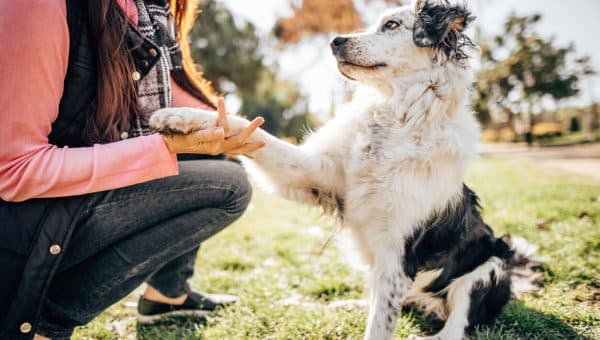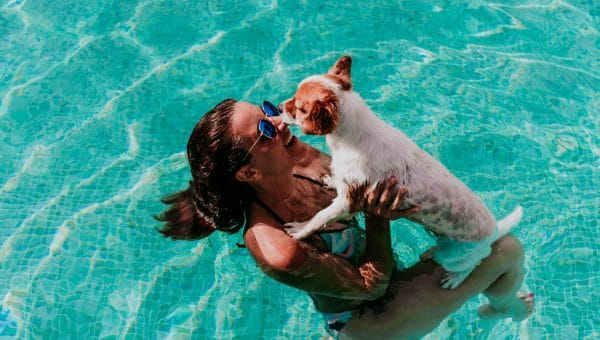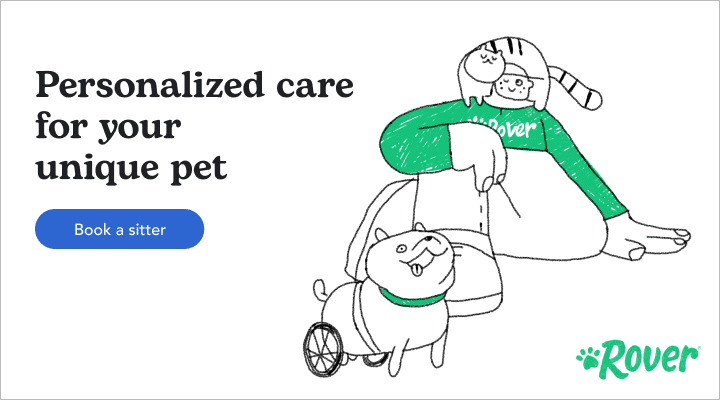- Not a substitute for professional veterinary help.
Stopping every few steps on a walk to let your dog pee? Sounds like your dog is into territory marking. Urine marking is a common and instinctive canine behavior. It typically starts when dogs reach sexual maturity—usually between the age of 6 to 12 months. Both males and female dogs mark with urine, but it’s most prevalent in unneutered male dogs.
Why do dogs do this? Essentially, it boils down to communication. Not only is a dog’s urinary system responsible for eliminating waste and balancing electrolytes, but it also provides them a way to leave important messages for other dogs.
Although territory marking is usually acceptable (even if it’s slow going) on outdoor strolls, it becomes problematic when a dog starts urinating in the house. Let’s learn why your dog might be doing it in the first place and what to do about this unwanted behavior.
Why Do Dogs Mark Territory?
At heart, territory marking is all about communication. By urinating, dogs leave behind small traces of their scent to alert other dogs of their presence. In a nutshell, territory urine marking is your dog’s way of saying: “this is mine” or “I was here.”
The pheromones in his urine also offer passing dogs information about his reproductive status and rank. If your veterinarian has already ruled out a medical condition, the following reasons may account for your dog’s urine marking.
Your dog isn’t spayed or neutered
Without question, the most frequent offenders are unneutered males. “Intact male dogs are stimulated more to mark due to hormonal influence and sexual arousal,” explains Dr. Corinne Wigfall, a veterinarian with SpiritDog Training. Unspayed females can spray, too, usually during periods of fertility.
Signaling they are ready to mate
Unneutered males have a tendency to urine mark when a female in heat is nearby. But they’re not alone in this: female dogs also engage in marking right before and during estrus—especially when they’re around a potential mate.
Someone new has visited
You might notice an uptick in urine marking after you’ve hosted new guests in your home. Unfamiliar visitors (both human and four-legged friends) can trigger a marking response in dogs as they reestablish their territory.
The same goes for visiting a new place with your dog. Some dogs will urine mark when visiting a friend’s home in an attempt to establish security in this unfamiliar setting.

iStock/TriggerPhoto
There’s a drastic change in their environment
Like unknown visitors, the introduction of radical changes to your dog’s world may increase urine marking. Novelty can rattle our dogs’ sense of security; this includes major changes (a new baby, a cross-country move, a different routine) as well as more mundane adjustments (say, a new piece of furniture). Consider if you’ve undergone any big life changes that could lie at the root of your dog’s behavior.
There’s another dog outside
If your dog can see or hear another dog through the window, they might urine mark as a way to communicate territory lines. And if a neighborhood dog is urinating near your property, it could cause a marking response in your own pet.
You have multiple pets in the home
Territory marking can occur in multi-dog homes when pets want to assert their dominance. This is especially common among pets of the same sex.
They’re anxious
“If your dog starts marking behavior where they previously had not, it can also be a sign of anxiety or stress,” Dr. Wigfall tells us. Canine stress can be attributed to a few culprits, including separation anxiety. Pet parents of nervous dogs may also observe submissive urination. Female dogs tend to display this behavior more often than males. Prior trauma can be a root cause of this anxious, submissive behavior.
What’s The Difference Between House Soiling & Territory Marking?
It’s important to distinguish natural urine marking from a medical urinary problem. It can be tricky to tell these apart, points out Dr. Wigfall. “As marking behavior is typically small volumes of urination produced frequently, it can be confused with urinary problems. However, a dog who is house-soiling will empty much more of their bladder.
A dog who urinates frequently in small volumes might be straining to pee, or it could be painful for them. Look at the urine’s color, too: discolored or bloody urine probably indicates a medical issue.
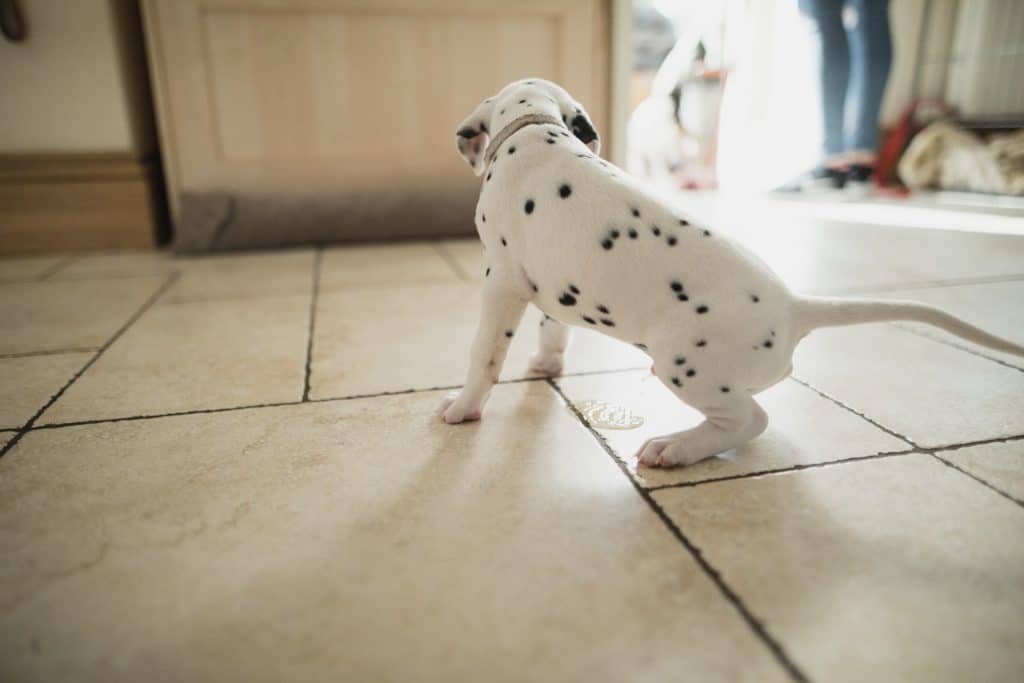
iStock/SolStock
If you notice changes in the frequency, urgency, or volume of your dog’s urine, a vet evaluation is a good idea. Your veterinarian can run bloodwork, diagnostic imaging, or urine analysis to determine if your dog’s soiling is caused by one of the following medical conditions:
- Urinary tract infections. UTIs are one of the most common infectious diseases in dogs. To help, your vet can prescribe a short-term antibiotic.
- Crystalluria. Some dogs, like Dalmatians, are predisposed to developing bladder stones made of uric acid. These can lead to kidney complications and problems with urination.
- Kidney infections. Increased thirst and urination can point to a kidney infection that needs to be treated with antibiotics.
- Endocrine diseases. Endocrine diseases that cause either too little or too much production of certain hormones can lead to an increase in urination. Depending on the situation, your vet may recommend surgery, radiotherapy, or medication to treat an endocrine condition.
- Metabolic diseases. Increased urination is a classic sign of diabetes, one of the most common metabolic diseases in dogs.
- Lack of house training. House soiling could just be a case of insufficient house training as a pup.
- Orthopedic problems. Dogs who struggle with mobility, like dogs with arthritis, might have a hard time getting to the backdoor when the urge to pee strikes.
- Age. Incontinence can also be a geriatric issue. As dogs get older, their mobility naturally declines, which can lead to more accidents.
How to Stop Dog Marking
To stop territory marking, it’s a good idea first to consult your veterinarian to ensure a medical condition isn’t to blame. Your vet can conduct an evaluation to identify signs of stress at home or possible illnesses that could be causing the behavior.
Once your vet rules out behavioral or medical issues, you can take the following steps to prevent unwanted marking in your home.
1. Neuter or spay your dog(s) right away
Getting your dog fixed will drastically lower instances of marking (as much as 80% in male dogs). The best time to do this is between 2 to 6 months, but neutering or spaying has been shown to help to some degree, regardless of age.
2. Thoroughly clean up urine when messes happen
Since dogs will re-mark areas that smell like urine, all traces of the scent need to be removed. The best way to get rid of dog pee smell is by soaking up the liquid immediately and using an enzymatic cleaner. Additionally, eliminating urine smell outdoors is often as simple as a quick hose-down.

iStock/zoranm
3. Block access to areas where they’re urinating
A baby gate or dog gate is useful for keeping your pet out of rooms they’re liable to mark, such as your bedroom, an outdoor area, or a living room.
4. Place new items out of reach
If your dog has a habit of leaving their scent on new things brought into the home (a couch or a rug, for example), try limiting their access as much as possible. Additionally, avoid placing new items around your dog’s most used spaces, like sleeping or eating areas.
5. Investigate for animals outside of your home
For dogs who become overstimulated watching another animal through the window (canine or otherwise), the solution could be as easy as closing the curtain. If neighborhood dogs are leaving their scent on your property, you can try using an outdoor odor neutralizer.
6. Closely supervise your dog
“Scent marking can be reduced by supervision of your dog around unfamiliar objects and places,” remarks Dr. Wigfall. Notice marking around new things? Wigfall advises teaching your dog to associate the area with non-marking activities, like playing or feeding instead. (Most dogs won’t want to pee where they eat, sleep, or play.)
7. Encourage them to mark outside while on walks
Give your dog plenty of opportunities to relieve themselves outside. When your dog marks appropriately while on a walk, shower them with praise and treats.

iStock/Evgeniy Negrey
8. Go back to toilet training
If you’re dealing with house soiling rather than scent marking, Dr. Wigfall says revisiting house training is the way forward. “Establishing a daily routine, using positive reinforcement, using a toileting ‘word’ when your dog correctly toilets, and rewarding correct elimination are successful techniques to properly teach your dog house training.” If your senior dog is marking territory, there might be special ways to re-potty train them, including close supervision, frequent encouragement, and utilizing potty pads.
9. Manage your dog’s anxiety
When nerves are to blame for urination, dog owners can choose from multiple remedies for anxiety. Some options that might work for your own dog include calming beds, calming chews, ThunderShirts, and pheromone sprays and diffusers. Even puzzle toys can help distract dogs from the stress of separation anxiety.
10. Purchase belly bands or doggie diapers
For temporary illnesses like a UTI, doggie diapers or belly bands come in handy for keeping messes to a minimum.
What Not to Do If Your Dog Marks Territory
As much as we dislike urine marking in our homes, it’s critical to avoid yelling or physically punishing our dogs for the behavior. Unfortunately, this tends to create fear and stress in dogs, which has a way of exacerbating the problem. Dogs can’t understand what we’re shouting at them. And research shows that treating your dog aggressively can trigger defensive aggression in response. FiveBarks veterinarian, Linda Simon, confirms this for Rover.
“We need to understand they are not trying to upset us; [dogs] are not sophisticated enough to think in this manner,” Simon explains. She says that punishment creates anxiety around toileting. This anxiety can cause a dog to hide away when toileting, making the habit even harder to break.
Instead, she notes it’s best to respond with patience and positive reinforcement.
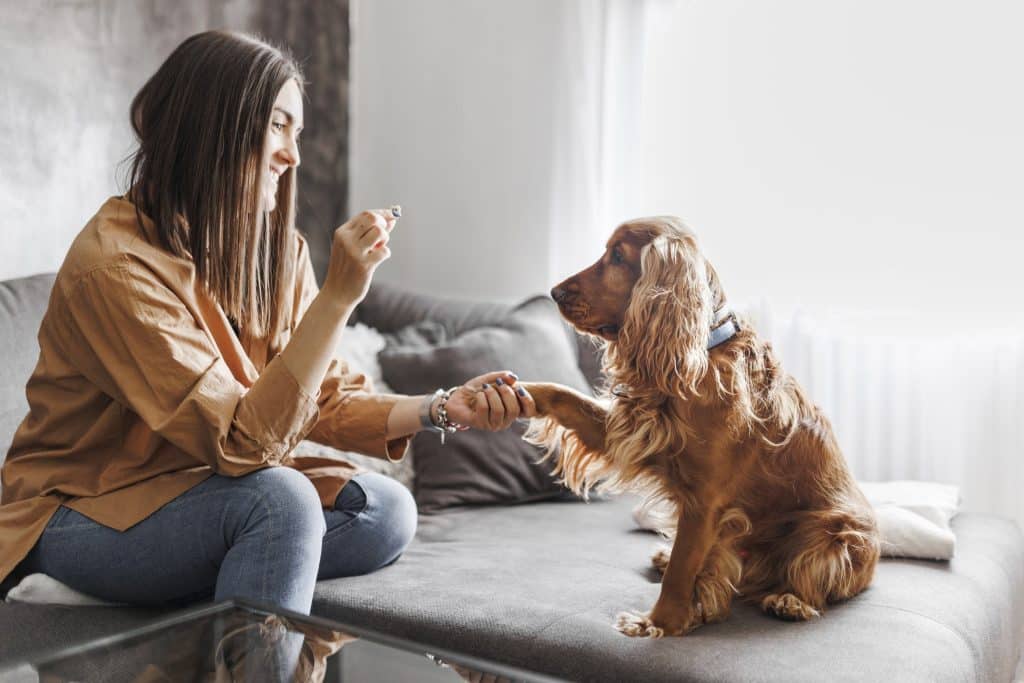
iStock/DjordjeDjurdjevic
The Bottom Line
Dog territory marking is a normal behavior—and one that’s acceptable when it occurs outside. Indoor urinating is another story. The key to dealing with unwanted urine marking indoors is prevention. How do you get ahead of “bad” behaviors? Get your dog fixed, supervise them closely, and praise them for good behavior.
Territory marking aside, it’s critical to get a handle on your dog’s training when dealing with a range of problematic behaviors that might arise—from destructive chewing and aggression to compulsive behaviors and separation anxiety. It may look like more work upfront, but your effort will be rewarded with a well-behaved companion at your side.



